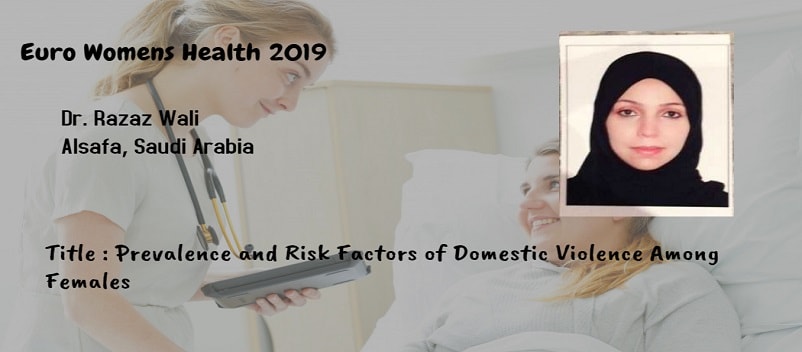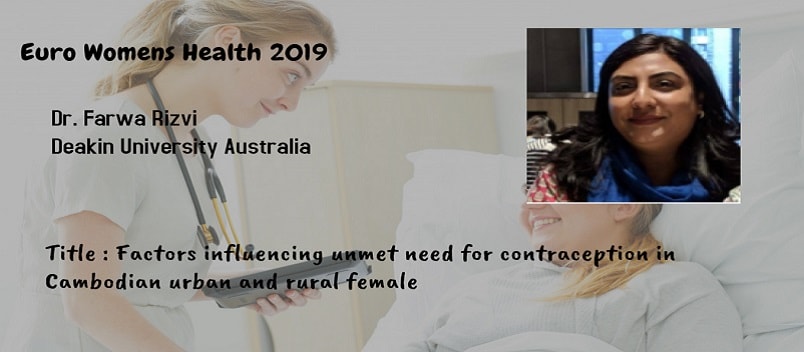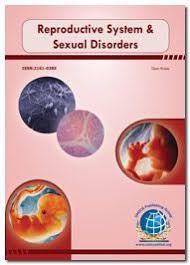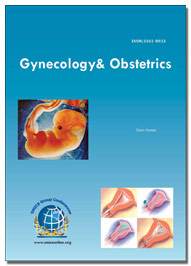Theme:
Euro Womens Health 2019
The Women’s Health Congress aims to discuss the comprehensive overview of the latest developments, innovations, challenges and strategies in the arena of Women’s Health ranging from Reproductive Medicine, Gynecology, Gynecologic Oncology, Maternal & fetal health, female infertility, In Vitro Fertilization (IVF), Intrauterine insemination (IUI), operative gynaecology and many more.
Many eminent Gynaecologists, Fertility specialist, researchers, scientists, and experts from both the Hospitals, Academia, and Industries will participate in this Women’s Health Congress to share their research experience via presentations, interactive case studies, Workshops, Symposiums, Oral Presentations, Poster Presentations, One to one meetings, Networking sessions, e-posters, and Plenary sessions, B2B etc. To recognize the Young Researchers and expert individuals exhibited outstanding research in the area of Gynaecology, Obstetrics, Reproductive Medicines, and other related expertise of Women’s Health, the Women’s Health 2019 Conference is planned to present the Young Research award through its Young Researcher Forum (YRF), Best Poster Award, and Best Presentation Award.
This Women’s Health Congress offers the best international platform to share the research knowledge among peer global experts, questions raised in the field of Women’s Health can be resolved through the consensus based expert opinions presented here at this Women’s health and Reproductive Medicine Congress.
We Welcome all to join us at this upcoming rewarding experience at Paris, where you can interact with top experts, engage yourself in a dedicated scientific networking environment, expand your knowledge and enhance your collaborative research in the field of Gynecology, Women’s Health & Reproductive Medicine.
Track 01.Womens health
Women's health has been a long concern but nowadays it has reached a supreme point of concern. Normally women and men share similar health challenges; only difference is that the health of women deserves particular attention. There are biological processes such as childbirth and pregnancy that carry health risks and are the principal cause of death in young women between 15 and 19 years old in developing countries. The leading cause of death among women of reproductive age is HIV/AIDS which is due to biological factors and limitation of women’s knowledge about HIV and unsafe sex. Lack of contraception results in unwanted pregnancies, unsafe abortions, sexually transmitted infections, etc.
- Healthy Aging
- Medication Safety
- Mental Health
Track 02.Gynaecology & Obstetrics
Gynaecology is the branch of medicine that focuses on women’s bodies and their reproductive health. It includes the diagnosis, treatment, and care of women’s reproductive system.
This includes the:
- vagina
- uterus
- ovaries
- fallopian tubes
This branch of medicine also includes screening for and treating issues associated with women’s breasts.
Gynaecology deals with any ailment concerning the reproductive organs; uterus, fallopian tubes, cervix, ovaries and vagina. A gynaecologist may also treat related problems in the bowel, bladder and urinary system since these are closely related to female reproductive organs.
Gynaecology is the overarching field of women’s health from puberty through adulthood. It represents most of the reproductive care you’ll receive during your lifetime. If you become pregnant, you’ll need to go to an obstetrician.
Obstetrics deals with the care of the pregnant women, the unborn baby, labor and delivery and the immediate period following childbirth. The obstetrician ensures that mother and child get the best prenatal care to ensure labor and delivery is accomplished without complications and that should intervention be needed, it is done quickly and safely.
Obstetrics is the branch of medicine related to medical and surgical care before, during, and after a woman gives birth. Obstetrics focuses on caring for and maintaining a woman’s overall health during maternity.
This includes:
- pregnancy
- labor
- childbirth
- the postpartum period
Track 03.Midwifery
Midwifery is the health science and health profession that deals with pregnancy, childbirth, and the postpartum period (including care of the new born in addition to the sexual and reproductive health of women throughout their lives. In many countries, midwifery is a medical profession (special for its independent and direct specialized education; should not be confused with the medical specialty, which depends on a previous general training). A professional in midwifery is known as a midwife.
A 2013 Cochrane review concluded that "most women should be offered midwifery-led continuity models of care and women should be encouraged to ask for this option although caution should be exercised in applying this advice to women with substantial medical or obstetric complications.The review found that midwifery-led care was associated with a reduction in the use of epidurals, with fewer episiotomies or instrumental births, and a decreased risk of losing the baby before 24 weeks' gestation. However, midwifery-led care was also associated with a longer mean length of labor as measured in hours.
A midwife is a trained health professional who helps healthy women during labor, delivery, and after the birth of their babies. Midwives may deliver babies at birthing centers or at home, but most can also deliver babies at a hospital.
Women who choose midwives usually want very little medical intervention and have had no complications during their pregnancy. Because giving birth to twins is more complicated than giving birth to a single baby, many doctors don't recommend using a midwife unless under the direct supervision of a doctor.
Midwifery encompasses care of women during pregnancy, labour, and the postpartum period, as well as care of the new-born. It includes measures aimed at preventing health problems in pregnancy, the detection of abnormal conditions, the procurement of medical assistance when necessary, and the execution of emergency measures in the absence of medical help.
Track 04..Reproductive and Sexual Health
Sexual health is a state of physical, mental and social well-being in relation to sexuality. It requires a positive and respectful approach to sexuality and sexual relationships, as well as the possibility of having pleasurable and safe sexual experiences, free of coercion, discrimination and violence.
Reproductive health generally refers to the diseases, disorders and conditions that affect the functioning of the male and female reproductive systems during all stages of life. Planning and having a healthy pregnancy is essential to the health of women, infants, and families and is especially important in preventing teen pregnancy and childbearing. Most of the Women’s came across many unique health issues related to reproduction and sexuality which are responsible for many health related problems experienced by women during their reproductive years (aged 15–44), of which unsafe sex is a major risk factor. To maintain Reproductive and Sexual Health, people must know the accurate information and the safe, effective, and acceptable contraception method of their choice.
Track 05.Pregnancy
Pregnancy, also known as gestation, is the time during which one or more offspring develops inside a woman.A multiple pregnancy involves more than one offspring, such as with twins. Pregnancy can occur by sexual intercourse or assisted reproductive technology. Childbirth typically occurs around 40 weeks from the last menstrual period (LMP) This is just over nine months, where each month averages 31 days. When measured from fertilization it is about 38 weeks. An embryo is the developing offspring during the first eight weeks following fertilization, after which, the term fetus is used until birth. Symptoms of early pregnancy may include missed periods, tender breasts, nausea and vomiting, hunger, and frequent urination. Pregnancy may be confirmed with a pregnancy test.
Track 06.Infertility
Infertility can be described as a woman who is unable to conceive as well as being unable to carry a pregnancy to full term. Infertility is the inability of a person, plant or an animal to reproduce by natural means. It is normally not the innate state of a healthy adult organism, except in particularly among certain eusocial species (predominantly haplodiploid insects). Understanding the socio demographic factors parallel with use may assist newly married couples with family planning. The use of infertility services is not random and roughly about 50% of the women evaluated for infertility progressed to treatment, and in which only a small proportion were treated with additional advanced assisted reproductive technologies essentially Invitro fertilization. Obesity in reproductive health will centralize on two important areas which are infertility and heavy menstrual bleeding. Women who are fertile will experience a natural period of fertility before and during ovulation, and they will be naturally infertile during the latter part of the menstrual cycle. Medical and surgical management of heavy menstrual bleeding is described including the many varied issues in hysterectomy of obese woman.
- Infertility Evaluation and Treatment Among Women
- Tubal Infertility and Ectopic Pregnancy
- Obesity & Surgical Management of Infertility
- Artificial Gametes and Ovarian Stimulation
- Risk of Idiopathic Male Infertility
- Infertility Evaluation and Management
Track 07.Reproductive Medicine
Reproductive Medicine in Gynaecology is ever growing area. The numbers of Research institutes which are working on reproductive medicine are approximately 120 and the number of Universities is around 20-30 which have the department of Medicine and the funding towards this research is over $90000 - $110000, Target audience are of Academia 20%, 50% industry and 30% of others. Reproductive medicine is a branch of medicine which focuses on prevention, diagnosis and management of the reproductive problems. The goals include improving or maintaining reproductive health and allowing people to have children at a time of their choice as discussed in many gynaecologic and gynaecologic worldwide. It is focused on knowledge of reproductive anatomy, physiology and endocrinology which also incorporates relevant aspects of molecular biology, biochemistry and pathology. Regenerative medicine emphasizes on process of replacing, engineering or regenerating human cells, tissues or organs to restore/establish normal function.
Track 08.Family Planning
The critical step in the management of world population includes Contraception and Family planning measures. The world is distinguishing a huge vault over in the development of recent contraceptive technologies and assisted reproductive technologies such as achieving pregnancy in procedures like in vitro fertilization, artificial insemination and surrogacy to fight issues like infertility and its assessment. High-risk patients include patients with diseases like hypertension, Sexually transmitted diseases, diabetes and other complications and the advancing trends in contraception and technologies will render a crucial role in regulating a large number of Reproductive Health indicators.
- Family Planning - Evaluation of Weight and Blood Pressure
- Advanced Methods in Family Planning
- Teenage Pregnancy
- Post-Abortion Family Planning
- Age at Menopause
- Contraceptive vs. Family planning
Track 09.Breastfeeding
Breast milk is the perfect food for the baby. It protects the baby against gastroenteritis and diarrhoea, ear and chest infections, allergies and diabetes. Breastfeeding reduces the risk of bleeding after the birth, is convenient. An early stage of nutrition for the infants starts from the mother’s milk. Immunity development for the child starts to improve eventually through the breast milk. Breastfeeding also helps in managing weight of the mother eventually. A midwife’s advice in the infant feeding at the initial stages after the birth of the child initially for the first three months after the birth adds to the mother’s health.
Track 10.Woman’s Oncology
Oncology is a branch of medicine that deals with the counteractive action, determination, and treatment of cancer. A therapeutic expert who rehearses oncology is an oncologist. The three parts which have enhanced survival in cancer are: Prevention - This is by lessening of hazard factors like tobacco and liquor utilization; Early analysis - Screening of common cancers and comprehensive diagnosis and staging.
Track 11.Breast and Ovarian Cancer
Breast cancer is the most widely recognized malignancy in women around the globe, with very nearly 1.8 million new cases in 2017 (second most customary disease when all is said in done). This addresses around 15% of all new cancers cases and 26% of all cancers in women. In 2018, a normal 266,000 new cases of an intrusive breast cancer are to be analysed in women in the U.S., nearby 64,000 new occurrences of in situ breast cancer. Ovarian cancer positions fifth in cancer death among women, representing a bigger number of deaths than some other cancers of the female reproductive system. A woman's risk of getting ovarian cancer amid her lifetime is around 1 out of 80.
Track 12. Menstrual Cycle
The menstrual cycle is the regular and natural change that occurs in the female reproductive system. This is a cycle of bodily changes controlled by the female hormones that cause a regular bleed, comes from the uterus. Regular menstrual periods in between the puberty and menopause are usually a sign that your body is working normally and healthy. Most of the women reports have some symptoms during the one to two weeks prior to menstruation.
Track 13.Menopause & Osteoporosis
Menopause is well known concept in Gynaecology. Menopause is the time in which when menstrual periods stop permanently, and they are no longer able to bear children are also known as climacteric. The number of Research institutes working on Menopause concepts are about 40-50 and the number of Universities are approximately 250 which are consisting menopause topics in the department of Gynaecology and the funding towards the research on this topic is in between the figures of $30000 - $50000, Target audience are of about 20% in the industry, Academia 40% and 40% of others. Menopause typically occurs between 49 and 52 years of age. Medical professionals often define menopause as having occurred when a woman has not had any vaginal bleeding for a year. It may also be defined by a decrease in hormone production by the ovaries. In those who have had surgery to remove their Uterus, but they still have ovaries, menopause may be viewed to have occurred at the time of the surgery or when their hormone levels fell. Following the removal of the uterus, this symptom typically occur earlier in the age of 45 years.
Osteoporosis resulted in weakening of bones and increases the risk of sudden or unexpected fractures. In Osteoporosis there are the loss of bone mass & strength resulting pours bones. Osteoporosis frequently progress without any noticeable symptoms or pains like other Women’s Health issues. The exact cause of Osteoporosis is unknown. The risk of developing Osteoporosis is common in woman at post menopause state. Osteoporosis is very common in women as compared to men. There are two types of Osteoporosis:
- Type I Osteoporosis: It is otherwise known as Postmenopausal Osteoporosis and happens after menopause at that time when estrogen levels decrease rapidly. During this, bone loss occurs in trabecular bones inside hard cortical bone.
- Type II Osteoporosis: Called as senile Osteoporosis and occurs after age of 70 and results in thinning of both the trabecular as well as cortical bone.
Track 14.Effect of Drugs on Pregnancy
Pregnancy is a special physiological condition where treatment of drug is an important concern as the physiology of pregnancy affects the pharmacokinetics of medication used some medications can reach the fetus and harms them. Medication to pregnant lady cannot be totally avoided since some may have chronic pathological conditions that require continuous or interrupted treatment like asthma, epilepsy and hypertension. New medical conditions can develop, and old ones get worsen during pregnancy requiring drug therapy, which becomes a major problem for child bearing women to take medication whether prescription, over-the counter, or herbal medication.
Track 15.Abortion and Women health
Abortion is removing an embryo or fetus from the uterus before it can survive outside the uterus, which ends the pregnancy. An abortion which is intentional is called as induced abortion and which occurs spontaneously is called as Miscarriage. Induced abortion has negative impact on the women’s health. Due to the induced abortion women faces problems like lower fertility, more vulnerable to Sexual Transmitted Diseases, breast Cancer and mental health. Unsafe abortion sometimes results in death and serious complications.
Track 16.Sexually transmitted infection
STIs are usually spread by having vaginal, oral, or anal sex. More than 9 million women in the United States are diagnosed with an STI each year. Women often have more serious health problems from STIs than men, including infertility.
An STI is an infection passed from one person to another person through sexual contact. An infection is when a bacteria, virus, or parasite enters and grows in or on your body. STIs are also called sexually transmitted diseases, or STDs.
Some STIs can be cured and some STIs cannot be cured. For those STIs that cannot be cured, there are medicines to manage the symptoms.
Track 17.Labor and Birth
In the women’s reproduction system labor is the last phase of pregnancy . What's more, the most widely recognized method for labor is a vaginal conveyance. Furthermore, it is of three phases that is the shortening and opening of the cervix plummet and birth of the infant, and the conveyance of the placenta. Typically a large portion of the infants are conceived head first.
- Onset of labour
- First stage: latent phase
- First stage: active phase
- Second stage: foetal expulsion
- Third stage: placenta delivery
- Fourth stage
Track 18.Autoimmune Diseases
Autoimmune disease occurs when body cells that eliminate threats, such as viruses, attack healthy cells. As this condition continues to escalate among the population, researchers remain baffled as to why the condition affects mostly women. While many distinct autoimmune diseases exist, most share symptoms such as:
â— Exhaustion
â— Mild fever
â— Pain
â— Skin irritation
â— Vertigo
Most of the autoimmune system rests in the stomach. Duly, many who suffer from this condition have resorted to natural healing practices, such as:
â— Consuming less sugar
â— Consuming less fat
â— Lowering stress
â— Reducing toxin intake
Track 19.Endometriosis
Endometriosis is the growth of tissues of the inner lines of the uterus to outside of uterus. In healthcare terms, lesions/nodules/implants are used to describes the endometrial patches. Most of the Endometriosis patches grow in the pelvic cavity and generally, on or over the two ovaries and ovaries, behind the uterus or tissues holding the uterus, and on the bowels or bladder. The major symptom is the pelvic pain very often linked with menstrual cycle, sometimes cramping during the period and the pain is worse than regular pains during the cycle. The main complication of Endometriosis is infertility. About 30-50% women suffering with Endometriosis face difficulties in their pregnancy.
- Diagnosis, Treatment & Management
- Clinical trials in Endometriosis
- Endometriosis: Risk factor for ovarian cancer/ Endometrial cancer?
- Endometriosis therapies: Elagolix (ABT–620), OBE2109, Relugolix , & Overest (leuprolide) etc.
- Challenges in Endometriosis treatment and future innovations
Track 20.Urogyneocology
Urogynecology is sub-division of gynaecology. Urogynaecologists are specially trained medical professionals who treats clinical problems related to dysfunction of the pelvic floor and bladder. In some countries Urogynecology is also known as Female Pelvic Medicine and Reconstructive Surgery. Some of the disorders in pelvic floor include urinary incontinence, pelvic organ prolapse and faecal incontinence. Other conditions where Urogynecology is practiced are Cystocele, Enterocyte, Female Genital Prolapse, Lichen sclerosus, Overactive Bladder and Rectovaginal fistula. In modern times, Urogynaecologists are responsible for the care of women who encounter trauma to the perineum during childbirth. Some of the tests which are performed in urogynaecologic pathology include Cystourethroscopy, urodynamic testing and Ultrasound. Urogynecologic problems are not life threatening, but they do have a major impact on the body of the individuals. The International Urogynecological Association (IUGA) is a global organisation dealing with the professionals practicing in the field of female pelvic medicine, reconstructive surgery and urogynecology. Some of the important treatments available in the sector of urogynecology includes abdominal reconstruction, behavioral modification, Botulinum toxin injection, dietary modification, robotic reconstruction, sacral nerve stimulation and urethral injection.
- Urinary incontinence
- Pelvic Organ Prolapse
Global Gynaecological Devices Market
The global gynaecological devices market is marked by a high degree of fragmentation due to the presence of numerous large manufacturers, reports Transparency Market Research (TMR) in a new business intelligence study. This leaves ample scope for market consolidation in the near future. Top companies like Boston Scientific Corporation, Cooper Surgical, and Olympus Corporation hold distinction on account of their widespread product portfolio and geographical outreach. These companies are struggling to introduce non-invasive devices to serve a larger consumer base which will eventually help expanding their geographical outreach.
The increasing demand for medical help for women- centric health issues is bringing in immense scope for growth in the gynaecological device market. The small regional players play an important role and hold a significantly higher share in the gynaecological device market. The increasing entry barriers and stringent rules and regulations for approval of a product are limiting the entry of new companies. Insufficient funding from venture capitalists is also creating a challenging situation for the entrance of newer companies.
As per projections of a TMR report, the global gynaecological devices market will clock 4.8% CAGR between 2017 and 2023. This will translate opportunities in the market to generate revenue of US$22,589.9 mn by 2023 from US$17,015.9 mn in 2017. In terms of device type, gynaecological surgical devices hold prominence in the market. Rising prevalence of single incision laparoscopic surgeries and advances in conventional endoscopic surgeries account for advances in gynaecological surgical instruments. Geography-wise, North America is a lucrative market for gynaecological devices due to the early adoption of advanced gynaecological devices.
Product Insights
Based on the product type, the global market is segmented into gynaecological imaging devices, surgical devices, and hand instruments. Surgical devices dominated the market with largest share in 2015. High usage of endoscopy devices and female contraceptives is the factor which can be attributable to the largest share.
The need for highly durable and easily autoclavable surgical instruments has been growing increasingly owing to the growing number of surgical procedures globally. Advancement in technology and introduction of highly efficient devices which can provide quick and accurate diagnosis and minimize the operating time are the factors expected to give boost to the market growth in the upcoming years.
Global market for Women’s Health
The global market for women’s health therapeutics will grow from nearly $33.0 billion in 2015 to nearly $40.6 billion by 2020, with a compound annual growth rate (CAGR) of 4.2% for the period of 2015-2020.
The infertility treatment devices market is expected to reach USD 3,698.92 Million by 2020 from USD 1,822.32 Million in 2015, at a CAGR of 15.21%. Infertility treatment devices are used in assisted reproductive technologies (ART) like in vitro fertilization, intracytoplasmic sperm injection, and surrogacy for the treatment of infertility.
- Engage yourself into the well-organized scientific program and networking environment
- Discuss your ideas and views with pioneers in the fields of gynaecology, obstetrics, midwifery and fertility
- Meet and interact with decision makers from both the private & government hospitals, and clinics from all round the globe
- Review & learn the latest trends and technologies in diagnosis and treatments of diseases related to obstetrics, gynaecology, fertility & management of Women’s Health
- Be a part of the interactive debates, plenary sessions and discussions about the current issues in the area of Women’s health and come to a consensus using evidence-based expert opinion
- Apply the latest developments into your clinical practice
- World-class platform to Exhibit your products and services
- 25+ presentations from Industry and Academia leaders.
- World Famous Landmarks
- Explore the Hidden Gems of Paris
- Stunning Theme Parks and Gardens
- Art Collections to Blow Your Mind
- Visit the Eiffel Tower
- Shop till You Drop
- The Most Delicious Food in the World
- Visit the Luxembourg Gardens
- Check out the nightlife at Oberkampf
Conference Highlights
- Womens health
- Gynaecology & Obstetrics
- Midwifery
- Reproductive and Sexual Health
- Pregnancy
- Infertility
- Reproductive Medicine
- Family Planning
- Breastfeeding
- Woman’s Oncology
- Breast and Ovarian Cancer
- Menstrual Cycle
- Menopause & Osteoporosis
- Effect of drugs on Pregnancy
- Abortion and Women health
- Sexually transmitted infection
- Labor and Birth
- Autoimmune Diseases
- Endometriosis
- Urogynecology
To share your views and research, please click here to register for the Conference.
To Collaborate Scientific Professionals around the World
| Conference Date | September 16-17, 2019 | ||
| Sponsors & Exhibitors |
|
||
| Speaker Opportunity Closed | |||
| Poster Opportunity Closed | Click Here to View | ||
Useful Links
Special Issues
All accepted abstracts will be published in respective Our International Journals.
- Journal of Womens Health Care
- Journal of Fertilization: In Vitro - IVF-Worldwide, Reproductive Medicine, Genetics & Stem Cell Bio
- Journal of Womens Health and Reproductive Medicine
Abstracts will be provided with Digital Object Identifier by

















